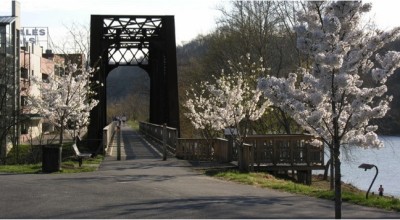U.S. Supreme Court Deals Blow to National Rails-to-Trails Movement
Justices Hand Property Owners Another Important Win, With Public Access the Loser
 Some U.S. Supreme Court decisions blow through American jurisprudence like a hurricane. Others slip into the law books quietly, like the proverbial cat’s paws.
Some U.S. Supreme Court decisions blow through American jurisprudence like a hurricane. Others slip into the law books quietly, like the proverbial cat’s paws.
Today’s Court decision in Marvin M. Brandt Revocable Trust v. United States falls into the latter category: largely overlooked by Court followers and the media, but with the potential to have profound, long-term impacts on public access rights, land use trends and private property rights.
The facts of Brandt are mundane, seemingly taken from a first-year law school Property exam–with a dollop of Western history added. Chief Justice Roberts’ majority opinion succinctly sets out the relevant historical backdrop of the case as well as the issue presented:
“In the mid-19th century, Congress began granting private railroad companies rights of way over public lands to encourage the settlement and development of the West. Many of those same public lands were later conveyed by the Government to homesteaders and other settlers, with the lands continuing to be subject to the railroads’ rights of way. The settlers and their successors remained, but many of the railroads did not. This case presents the question of what happens to a railroad’s right of way granted under…the General Railroad Right-of-Way Act of 1875 when the railroad abandons it: does it go to the Government, or to the private party who acquired the land underlying the right of way?”
In Brandt, the federal government in 1908 had granted a right-of-way under the 1875 Act to a private railroad over what were then public lands of the United States in Wyoming. Some 68 years later, the government sold a portion of those public lands to the Brandt family, making the sale expressly subject to the previously-granted railroad right-of-way burdening the parcel. Critically, the federal land grant failed to specify what would happen if and when the railroad ever abandoned its right-of-way. (So, apparently, did federal grants of public lands subject to railroad right-of-way easements throughout the entire American West; hence the significance of the Brandt case.)
Fast forward to 2004, when the railroad did just that–abandoning the right-of-way encumbering the Brandt family land grant. The government promptly announced to the Brandts that, notwithstanding the railroad’s abandonment, the government retained what it characterized as an “implied reversionary interest” in the easement under the 1875 Act. The Brandts disagreed, invoking normal easement principles that hold that when an easement is extinguished, the underlying property interest simply becomes unburdened of the easement. Faced with this impasse, the feds filed a quiet title action against the Brandts in federal court.
The government prevailed in both the district court and the 10th Circuit Court of Appeals. The problem, however, is that lower federal courts across the country were hopelessly split on the issue presented in Brandt; the Supreme Court predictably granted certiorari to resolve that conflict.
I’ll spare readers a detailed explication of the Supreme Court’s majority and dissenting opinions in Brandt. Suffice it to say that the Court reversed, ruling in favor of the Brandts in an 8-1 decision authored by Chief Justice Roberts. Justice Sotomayor wrote a dissenting opinion, and would have upheld the lower courts’ decision in favor of the government. It’s fair to say that both the majority and dissenting opinions reflect principled legal theories and plausible outcomes.
Why, then, is this a significant case from an environmental perspective? The answer lies in the rails-to-trails movement that has exploded in the United States over the past 50 years.
Beginning a century ago, the nation’s once-robust railroad system began to decline, as railroads lost out to new, alternative modes of transportation. As an inevitable result, thousands of railroad corridors across the nation were abandoned by railroad companies over the past century. With the railroads’ eclipse came a problem: what to do with the thousands of miles of unused rail corridors?
With the open space demands of an expanding U.S. population and heightened environmental consciousness of the 1960’s and `70’s came an appealing solution: convert the unused railroad rights-of-way to recreational trails for the use of hikers, bikers, cross-country skiers and horseback riders. And so the “Rails-to-Trails” movement was born. Conservation organizations and a host of local governments transformed abandoned railroad rights-of-ways into an extensive system of recreational trails stretching from Burlington, Vermont, to Burbank, California.
But the Rails-to-Trails movement proved controversial to private landowners and property rights organizations, who believe that such newly-created public accessways ignore the legitimate property interests of underlying and adjacent private landowners like the Brandts.
Remarkably, this important public policy context is not even mentioned in Chief Justice Roberts’ majority opinion in Brandt. To her credit, Justice Sotomayor concludes her dissent with the following apt statement:
“[T]he Court undermines the legality of thousands of miles of former rights of way that the public now enjoys as means of transportation and recreation. And lawsuits challenging the conversion of former rails to recreational trails alone may well cost American taxpayers hundreds of millions of dollars.”
Whatever else can be said of the Supreme Court’s decision in Brandt, Justice Sotomayor is undoubtedly correct that today’s ruling will have a chilling effect on future efforts to convert abandoned railroad rights-of-way into recreational trails–especially in the Western states where the Act of 1875 and federal land grants predominate. Additionally, and as both the government’s legal arguments and Justice Sotomayor’s dissent caution, many private landowners in the same legal position as the Brandts can now be expected to flood the U.S. Court of Federal Claims with demands for financial compensation if local governments seek to maintain the extensive system of recreational trails previously created from abandoned railroad corridors.
In sum, the Supreme Court’s decision in Brandt represents yet another in an almost-unbroken string of property rights decisions issued by the Roberts Court in recent years. And the ruling threatens to undermine a critically important public access system of recreational trails that has served the American public exceedingly well over the past half century.
Reader Comments
One Reply to “U.S. Supreme Court Deals Blow to National Rails-to-Trails Movement”
Comments are closed.







I fail to see how the Brandt decision should be characterized as a “cat’s paw” (with all the negative implications attached to that phrase), rather than a faithful application of well-settled rules of property law. The article suggests that the Court should have interpreted the historical conveyance of a railway right-of-way under the government’s modern policy toward public lands. But there is no basis in law for such a shifting approach to land conveyances. Indeed, why should current policies toward former public lands be relevant when interpreting a land title that was issued nearly a century ago? Isn’t the interest in maintaining predictability and certainty of title more important than the public’s shifting interests toward former public lands? Also, isn’t Justice Sotomayor’s concern that taxpayers will have to pay to convert certain types of abandoned rights-of-way into recreational trails exactly what the Takings Clause requires when private property is put to a public use?